The role of varenicline on alcohol-primed self-administration and seeking behavior in rats
- PMID: 25656746
- PMCID: PMC4482789
- DOI: 10.1007/s00213-015-3878-1
The role of varenicline on alcohol-primed self-administration and seeking behavior in rats
Abstract
Rationale: Varenicline, a smoking-cessation agent, may be useful in treating alcohol use disorders. An important consideration when studying factors that influence drinking/relapse is influence of the pharmacological effects of alcohol on these behaviors. Pre-exposure to alcohol (priming) can increase craving, drinking, and seeking behaviors.
Objectives: The primary goal of this work was to determine the effects of varenicline on alcohol-primed self-administration and seeking behavior in male Long-Evans rats.
Methods: First, we assessed whether varenicline (0, 0.3, 1, 3 mg/kg, IP) has alcohol-like discriminative stimulus effects and whether varenicline alters sensitivity to alcohol in rats trained to discriminate a moderate alcohol dose (1 g/kg, IG) vs. water. Second, animals trained to self-administer alcohol underwent assessments to test the effects of: (i) varenicline (0, 0.3, 1, 3 mg/kg, IP) on self-administration, (ii) alcohol priming (0, 0.3, 1 g/kg, IG) on self-administration and seeking behavior, and (iii) varenicline (1 mg/kg) in combination with alcohol priming (1 g/kg) on these behaviors.
Results: Varenicline did not substitute for alcohol but disrupted the expression of sensitivity to alcohol. Varenicline decreased self-administration but only at a motor-impairing dose (3 mg/kg). Alcohol priming decreased self-administration and seeking behavior. Varenicline (1 mg/kg) blocked this effect under self-administration conditions, but not seeking conditions, which effectively resulted in increased alcohol intake.
Conclusions: These findings suggest the importance of further behavioral and mechanistic studies to evaluate the use of varenicline in treating alcohol use disorders and its potential impact on drinking patterns in smokers using varenicline as a smoking-cessation aid.
Figures

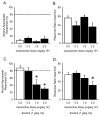
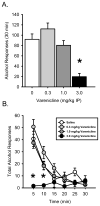
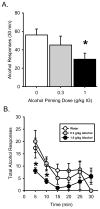
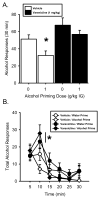
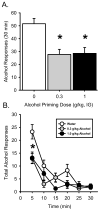

Similar articles
-
The Effects of Long-Term Varenicline Administration on Ethanol and Sucrose Seeking and Self-Administration in Male P Rats.Alcohol Clin Exp Res. 2018 Feb;42(2):453-460. doi: 10.1111/acer.13562. Epub 2017 Dec 23. Alcohol Clin Exp Res. 2018. PMID: 29168193 Free PMC article.
-
The effects of varenicline on alcohol seeking and self-administration in baboons.Alcohol Clin Exp Res. 2014 Feb;38(2):376-83. doi: 10.1111/acer.12233. Epub 2013 Aug 19. Alcohol Clin Exp Res. 2014. PMID: 24033702 Free PMC article.
-
The nicotine + alcohol interoceptive drug state: contribution of the components and effects of varenicline in rats.Psychopharmacology (Berl). 2016 Aug;233(15-16):3061-74. doi: 10.1007/s00213-016-4354-2. Epub 2016 Jun 22. Psychopharmacology (Berl). 2016. PMID: 27334469 Free PMC article.
-
Varenicline decreases nicotine but not alcohol self-administration in genetically selected Marchigian Sardinian alcohol-preferring (msP) rats.Drug Alcohol Depend. 2015 Nov 1;156:126-132. doi: 10.1016/j.drugalcdep.2015.09.002. Epub 2015 Sep 8. Drug Alcohol Depend. 2015. PMID: 26383997 Free PMC article.
-
The effects of varenicline on methamphetamine self-administration and drug-primed reinstatement in female rats.Behav Brain Res. 2016 Mar 1;300:150-9. doi: 10.1016/j.bbr.2015.11.033. Epub 2015 Nov 27. Behav Brain Res. 2016. PMID: 26638833 Free PMC article.
Cited by
-
Functional role for cortical-striatal circuitry in modulating alcohol self-administration.Neuropharmacology. 2018 Mar 1;130:42-53. doi: 10.1016/j.neuropharm.2017.11.035. Epub 2017 Nov 26. Neuropharmacology. 2018. PMID: 29183687 Free PMC article.
-
Discovery of a Potent, Selective, and Brain-Penetrant Small Molecule that Activates the Orphan Receptor GPR88 and Reduces Alcohol Intake.J Med Chem. 2018 Aug 9;61(15):6748-6758. doi: 10.1021/acs.jmedchem.8b00566. Epub 2018 Jul 30. J Med Chem. 2018. PMID: 30011199 Free PMC article.
-
Effects of the nicotinic agonist varenicline, nicotinic antagonist r-bPiDI, and DAT inhibitor (R)-modafinil on co-use of ethanol and nicotine in female P rats.Psychopharmacology (Berl). 2018 May;235(5):1439-1453. doi: 10.1007/s00213-018-4853-4. Epub 2018 Feb 18. Psychopharmacology (Berl). 2018. PMID: 29455292 Free PMC article.
-
The role of nicotinic acetylcholine receptors in alcohol-related behaviors.Brain Res Bull. 2020 Oct;163:135-142. doi: 10.1016/j.brainresbull.2020.07.017. Epub 2020 Jul 22. Brain Res Bull. 2020. PMID: 32707263 Free PMC article. Review.
-
Effect of Lowering the Dose of Varenicline on Alcohol Self-administration in Drinkers With Alcohol Use Disorders.J Addict Med. 2016 May-Jun;10(3):166-73. doi: 10.1097/ADM.0000000000000208. J Addict Med. 2016. PMID: 27159341 Free PMC article. Clinical Trial.
References
Publication types
MeSH terms
Substances
Grants and funding
LinkOut - more resources
Full Text Sources
Other Literature Sources

